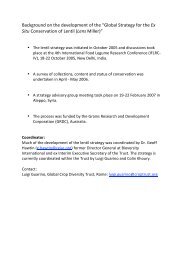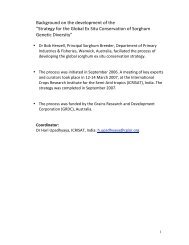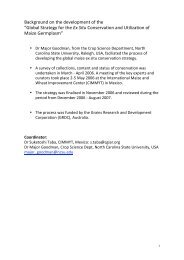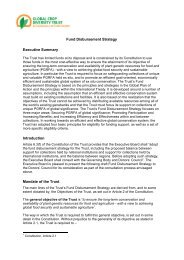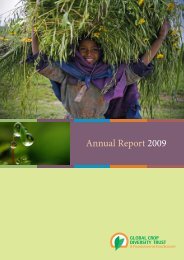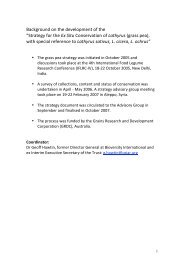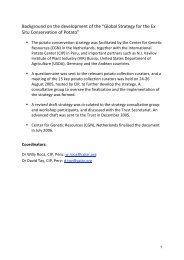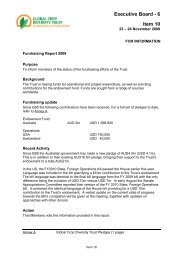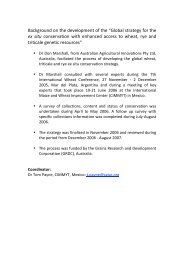Regional strategy for the ex situ conservation of - Global Crop ...
Regional strategy for the ex situ conservation of - Global Crop ...
Regional strategy for the ex situ conservation of - Global Crop ...
Create successful ePaper yourself
Turn your PDF publications into a flip-book with our unique Google optimized e-Paper software.
DisclaimerThis document has been developed by <strong>the</strong> Eastern Africa Plant Genetic Resources Network(EAPGREN). For more in<strong>for</strong>mation about <strong>the</strong> network, see: //www.asareca.orgThe objective <strong>of</strong> this Strategy is to provide a framework <strong>for</strong> <strong>the</strong> efficient and effective <strong>ex</strong> <strong>situ</strong><strong>conservation</strong> <strong>of</strong> <strong>the</strong> most important crop diversity collections in <strong>the</strong> Eastern Africa region, andto promote <strong>the</strong> availability <strong>of</strong> <strong>the</strong>se plant genetic resources <strong>for</strong> food and agriculture.The <strong>Global</strong> <strong>Crop</strong> Diversity Trust (<strong>the</strong> Trust) provided support towards this initiative andconsiders <strong>the</strong> document, particularly those portions pertaining directly to <strong>the</strong> Trust’s mandatedareas <strong>of</strong> interest, to be an important input to <strong>the</strong> Trust’s own planning and work. We <strong>ex</strong>pect<strong>the</strong> Strategy to continue to evolve, as appropriate, and <strong>for</strong> <strong>the</strong> Network to lead this on-goingprocess.The <strong>Regional</strong> Strategy is <strong>the</strong> <strong>strategy</strong> <strong>of</strong> <strong>the</strong> region. The Trust does not take responsibility <strong>for</strong>its contents or <strong>for</strong> <strong>the</strong> accuracy or completeness <strong>of</strong> <strong>the</strong> in<strong>for</strong>mation contained in <strong>the</strong> document.Please direct specific questions and comments to <strong>the</strong> regional <strong>strategy</strong> coordinator mentionedin <strong>the</strong> document.<strong>Global</strong> <strong>Crop</strong> Diversity TrustDecember 20063
Consequently, both domestic interests and <strong>the</strong> international agenda provide compelling need<strong>for</strong> countries to engage in processes that enhance <strong>the</strong> <strong>conservation</strong> and sustainable use <strong>of</strong> plantgenetic resources. The problem is that most <strong>of</strong> <strong>the</strong> EAPGREN member countries areconfronted with major problems that inhibit <strong>the</strong>m from making progress in this area. Although<strong>the</strong> political awareness and commitment to <strong>conservation</strong> and use <strong>of</strong> plant genetic resources aresignificant, <strong>the</strong> budget allocations by respective national governments are <strong>of</strong>ten inadequatedue to prevailing economic hardships.The Report on <strong>the</strong> State <strong>of</strong> <strong>the</strong> World’s Plant Genetic Resources <strong>for</strong> Food and Agriculturehighlighted that many <strong>ex</strong> <strong>situ</strong> germplasm collections in Africa are in a state <strong>of</strong> deterioration,facing severe constraints due to increased maintenance costs, etc. (FAO, 1998)*. <strong>Crop</strong>diversity, once lost, is impossible to replace and it is important that <strong>the</strong>se collections be keptin a healthy state and continually accessible <strong>for</strong> use on sustainable manner.In this cont<strong>ex</strong>t, <strong>the</strong> <strong>Global</strong> <strong>Crop</strong> Diversity Trust’s (<strong>the</strong> Trust) initiative to support regional<strong>conservation</strong> strategies provides EAPGREN a window <strong>of</strong> opportunity to develop a regional<strong>conservation</strong> system and identify collections <strong>of</strong> priority <strong>for</strong> support complementing thosefrom o<strong>the</strong>r donors and <strong>the</strong> national governments <strong>for</strong> sustainable <strong>conservation</strong> <strong>of</strong> importantcrop diversity from <strong>the</strong> sub-region. There<strong>for</strong>e, <strong>the</strong> objective <strong>of</strong> this scheme is to develop <strong>the</strong>regional <strong>conservation</strong> <strong>strategy</strong> <strong>for</strong> Eastern Africa outlining <strong>the</strong> steps and resources needed toguarantee <strong>the</strong> safe management and continued availability <strong>of</strong> its most important cropdiversity.The goal <strong>of</strong> EAPGREN is to develop sufficient capacities in participating countries <strong>of</strong> <strong>the</strong>sub-region <strong>for</strong> effective <strong>conservation</strong> and sustainable utilization <strong>of</strong> <strong>the</strong>ir plant geneticresources, as a component <strong>of</strong> <strong>the</strong> broader vision <strong>of</strong> achieving food security, economicdevelopment and sustainable agricultural development. The network aims at streng<strong>the</strong>ningcollaboration, networking, and linkages between <strong>conservation</strong> and utilization <strong>of</strong> plant geneticresources at both national and sub-regional levels through <strong>the</strong> pooling <strong>of</strong> resources and use <strong>of</strong>comparative advantages available in <strong>the</strong> various institutions and countries.The mission <strong>of</strong> <strong>the</strong> network is to harness, conserve, and to promote greater use <strong>of</strong> plantgenetic resources <strong>for</strong> food security, improved health, and socio-economic advancement <strong>of</strong> <strong>the</strong>rural communities. This mission will be achieved through capacity building and developingsustainable linkages between plant genetic resources <strong>conservation</strong> and utilization among <strong>the</strong>various stakeholders including rural farming communities.Implementation <strong>of</strong> <strong>the</strong> network activities is through five <strong>the</strong>mes namely Ex <strong>situ</strong> Conservation,In-<strong>situ</strong> Conservation, Utilization, In<strong>for</strong>mation and Documentation, Policy and PublicAwareness. Through <strong>the</strong>se <strong>the</strong>mes scientific support and opportunities will be provided to awide range <strong>of</strong> stakeholders.6
3. Introduction to <strong>the</strong> TrustThe <strong>Global</strong> <strong>Crop</strong> Diversity Trust (<strong>the</strong> Trust) aims to support <strong>the</strong> long-term maintenance <strong>of</strong> anefficient and effective arrangement <strong>for</strong> <strong>the</strong> <strong>ex</strong> <strong>situ</strong> <strong>conservation</strong> <strong>of</strong> <strong>the</strong> most important cropcollections around <strong>the</strong> world. A first filter <strong>for</strong> eligibility is provided by <strong>the</strong> eligibilityprinciples <strong>of</strong> <strong>the</strong> Trust. Meeting <strong>the</strong>se principles is <strong>the</strong> minimum requirement <strong>for</strong> a collectionto be eligible <strong>for</strong> support: The plant genetic resources are <strong>of</strong> crops included in Ann<strong>ex</strong> 1 or referred to in Article 15.1(b) <strong>of</strong> <strong>the</strong> International Treaty on Plant Genetic Resources <strong>for</strong> Food and Agriculture(ITPGRFA) The plant genetic resources are accessible under <strong>the</strong> internationally agreed terms <strong>of</strong> accessand benefit sharing provided <strong>for</strong> in <strong>the</strong> multilateral system as set out in <strong>the</strong> InternationalTreaty Each holder <strong>of</strong> plant genetic resources <strong>for</strong> food and agriculture commits to its long term<strong>conservation</strong> and availability Each recipient <strong>of</strong> funds from <strong>the</strong> Trust shall undertake to work in partnership with <strong>the</strong> aim<strong>of</strong> developing an efficient and effective global <strong>conservation</strong> systemTo achieve this ultimate goal, <strong>the</strong> Trust is supporting <strong>the</strong> development <strong>of</strong> <strong>conservation</strong>strategies that will guide <strong>the</strong> allocation <strong>of</strong> resources to <strong>the</strong> most important and needy cropdiversity collections, assisting <strong>the</strong>m to meet <strong>the</strong> criteria required <strong>for</strong> long term <strong>conservation</strong>funding. The <strong>conservation</strong> strategies are proposing <strong>the</strong> collections and <strong>conservation</strong> servicesand providers <strong>of</strong> priority <strong>for</strong> support by <strong>the</strong> Trust. The Trust is supporting two complementaryand mutually rein<strong>for</strong>cing approaches to identifying and prioritizing eligible collections <strong>for</strong>upgrading and long-term <strong>conservation</strong> funding. One approach is to identify key <strong>ex</strong> <strong>situ</strong>collections <strong>of</strong> globally important crops (<strong>of</strong> Ann<strong>ex</strong> 1 <strong>of</strong> <strong>the</strong> ITPGRFA) on a region-by-regionbasis. The o<strong>the</strong>r is to prioritize collections on a crop-by-crop basis at <strong>the</strong> global level. The<strong>strategy</strong> should consider <strong>the</strong> most appropriate approach to managing <strong>the</strong> key collections, given<strong>the</strong>ir location and available resources, and <strong>the</strong> standards <strong>the</strong>y should be <strong>ex</strong>pected to fulfil in<strong>the</strong> management <strong>of</strong> <strong>the</strong> given crop. Finally, it will propose a model <strong>for</strong> sharing responsibilities<strong>for</strong> certain activities amongst collection holders and service providers, and identify andprioritize collections <strong>for</strong> long-term <strong>conservation</strong> support. This process brings toge<strong>the</strong>r <strong>the</strong>managers <strong>of</strong> plant genetic resources and o<strong>the</strong>r <strong>ex</strong>perts to develop and implement <strong>the</strong> most costefficient and effective strategies <strong>for</strong> ensuring <strong>the</strong> long-term <strong>conservation</strong> and availability <strong>of</strong><strong>the</strong> crops that are vital to <strong>the</strong> world’s food security.4. Goal <strong>of</strong> <strong>the</strong> regional <strong>conservation</strong> <strong>strategy</strong>Sustainable <strong>conservation</strong> and utilization <strong>of</strong> crop genetic diversity <strong>for</strong> agricultural developmentand food security in Eastern Africa.5. ObjectiveThe efficient and effective <strong>conservation</strong> and utilization <strong>of</strong> Eastern Africa’s plant geneticresources and identify priority collections eligible <strong>for</strong> long-term support from <strong>the</strong> Trust and<strong>the</strong>ir urgent upgrading and capacity building needs. The regional <strong>conservation</strong> <strong>strategy</strong>, willhave <strong>the</strong> broad buy-in and support from all <strong>the</strong> key stakeholders, and will promote <strong>the</strong>7
ationalization <strong>of</strong> <strong>conservation</strong> ef<strong>for</strong>ts at regional and global levels through encouragingpartnerships and sharing <strong>conservation</strong> responsibilities, facilities and tasks and will link with<strong>the</strong> relevant global crop <strong>conservation</strong> strategies.6. OutputsDiversity <strong>of</strong> regional priority crops conserved safely on a long-term basisGenetic diversity <strong>of</strong> priority crops characterized and documentedManagement <strong>of</strong> <strong>ex</strong> <strong>situ</strong> collections <strong>of</strong> priority crops improvedIn<strong>for</strong>mation sharing mechanisms streng<strong>the</strong>ned within <strong>the</strong> network and linked to globalinitiativesUse <strong>of</strong> germplasm <strong>of</strong> priority crops by users optimizedCapacity <strong>of</strong> national programmes in management <strong>of</strong> priority crop collections streng<strong>the</strong>nedStronger partnership and collaboration within EAPGREN and outside <strong>the</strong> region in <strong>ex</strong> <strong>situ</strong><strong>conservation</strong> <strong>of</strong> PGRFA7. Anticipated impactThe development <strong>of</strong> <strong>the</strong> regional <strong>strategy</strong> document will provide <strong>the</strong> framework <strong>for</strong>sustainable <strong>conservation</strong> <strong>of</strong> plant genetic resources leading to improved agriculturalproduction and food security in Eastern Africa with direct implications to addressing <strong>the</strong>Millennium Development Goals related to food security and reducing hunger.8. Intended beneficiariesThe primary beneficiaries are <strong>the</strong> PGR programmes in member countries <strong>of</strong> EAPGRENincluding Burundi, Eritrea, Ethiopia, Kenya, Madagascar, Rwanda, Sudan and Uganda. Thesecondary beneficiaries are <strong>the</strong> crop improvement programmes in <strong>the</strong> region throughincreased access to a wide range <strong>of</strong> crop genetic diversity to produce superior varieties with aspillover to neighboring regions. The ultimate beneficiaries are <strong>the</strong> farmers owing toimproved agricultural productivity through agricultural research and development programs in<strong>the</strong> region and beyond.9. Process <strong>of</strong> developing <strong>the</strong> regional <strong>conservation</strong> <strong>strategy</strong>The process <strong>of</strong> developing <strong>the</strong> regional <strong>conservation</strong> <strong>strategy</strong> with EAPGREN was initiatedduring <strong>the</strong> 4th Steering Committee meeting in August 2004, Antananarivo, Madagascar. Itwas agreed that <strong>the</strong> <strong>strategy</strong> should be led by EAPGREN Coordinator and facilitated with <strong>the</strong>technical support <strong>of</strong> Bioversity International. At <strong>the</strong> 4th <strong>Regional</strong> Steering Committee (RSC),<strong>the</strong> network members were introduced to <strong>the</strong> regional and global crop <strong>conservation</strong> strategies<strong>of</strong> <strong>the</strong> <strong>Global</strong> <strong>Crop</strong> Diversity Trust. They proposed a preliminary list <strong>of</strong> most important crops<strong>of</strong> Ann<strong>ex</strong> 1 (<strong>of</strong> ITPGRFA) to <strong>the</strong> region and some areas that would require capacity buildingand support from <strong>the</strong> Trust. The RSC agreed on <strong>the</strong> process and timeline to develop <strong>the</strong>regional <strong>conservation</strong> <strong>strategy</strong>. A Task Force <strong>of</strong> four people (A. Demissie, H. Kamau, K. Raoand John Mulumba-Waswa) was established to undertake <strong>the</strong> activities towards <strong>the</strong>development <strong>of</strong> <strong>the</strong> <strong>strategy</strong>. The Task Force members collated <strong>ex</strong>isting in<strong>for</strong>mation oncollections <strong>of</strong> crops on Ann<strong>ex</strong> 1 <strong>of</strong> <strong>the</strong> Treaty held within <strong>the</strong> region and attempted to fill in8
<strong>the</strong> gaps with a survey undertaken through <strong>the</strong> national coordinators in August 2005. Thein<strong>for</strong>mation included: collection holders; species, type and number <strong>of</strong> accessions <strong>of</strong> <strong>the</strong>individual collections; passport data where possible; any o<strong>the</strong>r relevant in<strong>for</strong>mation available.The main questions that were asked were:1) Which crops on Ann<strong>ex</strong> 1 <strong>of</strong> <strong>the</strong> Treaty are <strong>of</strong> greatest importance to <strong>the</strong> agriculture <strong>of</strong> <strong>the</strong>region or to one or a few countries in <strong>the</strong> region?2) Which <strong>of</strong> <strong>the</strong> identified above crops have <strong>the</strong> region as <strong>the</strong>ir primary or secondary centre<strong>of</strong> diversity?3) Which collections <strong>of</strong> <strong>the</strong> crops identified are ‘most important’ in terms <strong>of</strong> size,<strong>ex</strong>tent/scope <strong>of</strong> diversity, concentration <strong>of</strong> wild relatives and o<strong>the</strong>r standards <strong>of</strong> <strong>the</strong>measurement <strong>of</strong> importance as defined by network members?4) Among <strong>the</strong> collections identified, what collections meet <strong>the</strong> Trust’s eligibility principles?5) Among <strong>the</strong> subset <strong>of</strong> collections identified that meet <strong>the</strong> Trust’s eligibility principles,which <strong>of</strong> <strong>the</strong>se collections should be given first priority <strong>for</strong> receiving funding <strong>for</strong>upgrading and capacity building? The assignment <strong>of</strong> relative priority amongst collectionscould involve <strong>the</strong> consideration <strong>of</strong> <strong>the</strong> following points:○ The <strong>ex</strong>tent, urgency and nature <strong>of</strong> actual or potential threats to <strong>the</strong> collection○ The <strong>ex</strong>tent, urgency and nature <strong>of</strong> actual or potential threats to <strong>the</strong> crop in <strong>the</strong> field○ The availability <strong>of</strong> alternative funding sources to support <strong>the</strong> <strong>conservation</strong> <strong>of</strong> aspecific collection○ Whe<strong>the</strong>r <strong>the</strong> collection is held in a genebank maintaining o<strong>the</strong>r eligible collections○ The availability <strong>of</strong> o<strong>the</strong>r arrangements to support <strong>the</strong> <strong>conservation</strong> <strong>of</strong> identifiedpriority collectionsA preliminary assessment <strong>of</strong> <strong>the</strong> opportunities <strong>for</strong> collaboration was made <strong>for</strong> ensuring <strong>the</strong>most effective and efficient approach to conserving <strong>the</strong> eligible collections identified drawingon partners both within and outside <strong>of</strong> <strong>the</strong> region <strong>for</strong> <strong>the</strong> provision <strong>of</strong> <strong>conservation</strong> services.The senior managers <strong>of</strong> NARS were consulted in <strong>the</strong> respective countries <strong>for</strong> <strong>the</strong>ir views on<strong>the</strong> <strong>strategy</strong> and <strong>the</strong> most effective collaborative arrangements <strong>for</strong> sustainable <strong>conservation</strong> <strong>of</strong><strong>the</strong> PGRFA in <strong>the</strong> region.The consultation <strong>of</strong> <strong>the</strong> EAPGREN Network members during <strong>the</strong> 5th Steering Committeemeeting in Khartoum, Sudan on 19-23 September 2005 was to validate and fur<strong>the</strong>r discuss <strong>the</strong>preliminary assessment <strong>of</strong> crops and collections <strong>of</strong> most importance, <strong>of</strong> <strong>the</strong> possiblecollaborative arrangements and on <strong>the</strong> upgrading and capacity building needs <strong>of</strong> <strong>the</strong> prioritycollections. The goal <strong>of</strong> upgrading and capacity building is to enable <strong>the</strong> collections to putinto place <strong>the</strong> structures, skills and policies needed in order to meet <strong>the</strong> criteria <strong>for</strong> receiving<strong>conservation</strong> funding over <strong>the</strong> long-term. Based on <strong>the</strong> outcome <strong>of</strong> <strong>the</strong>se assessments, <strong>the</strong><strong>strategy</strong> <strong>for</strong> an efficient and effective system <strong>of</strong> <strong>conservation</strong> <strong>of</strong> <strong>the</strong> collections has beenidentified in <strong>the</strong> cont<strong>ex</strong>t <strong>of</strong> <strong>the</strong> region.In <strong>the</strong> Khartoum meeting a limited number <strong>of</strong> countries including Eritrea, Sudan, Burundi,and Rwanda participated. In <strong>the</strong> follow-up consultative meeting held in Nairobi on 12-13November 2005. All <strong>the</strong> countries <strong>of</strong> <strong>the</strong> EAPGREN constituency were represented through<strong>the</strong> focal persons and <strong>the</strong>ir representative from <strong>the</strong> national agricultural research system. Thecurrent document was produced after <strong>the</strong> Nairobi meeting and <strong>the</strong> outcome <strong>of</strong> <strong>the</strong> consultationwas circulated to <strong>the</strong> ASARECA community including to <strong>the</strong> members <strong>of</strong> <strong>the</strong> ASARECAhighest policy making organ.9
10. <strong>Crop</strong>s <strong>of</strong> greatest importance<strong>Crop</strong>s <strong>of</strong> greatest importance were identified based on <strong>the</strong> ranking and weights in terms <strong>of</strong>importance/standing assigned to each <strong>of</strong> <strong>the</strong> following nine criteria by <strong>the</strong> EAPGREN<strong>Regional</strong> Steering Committee members at <strong>the</strong> 4th RSC meeting (31Aug-3 Sept 2004),Madagascar and subsequently by <strong>the</strong> task<strong>for</strong>ce which met on 24-25 Jan 2005 in Nairobi. Threats <strong>of</strong> GE Centre <strong>of</strong> diversity Uniqueness Food security Status <strong>of</strong> PGR collections – health Status <strong>of</strong> characterization Conservation facilities – long term Safety duplication Regeneration needsTable 1: <strong>Crop</strong>s <strong>of</strong> priority to <strong>the</strong> region identified using <strong>the</strong> criteria set and <strong>the</strong> indicators <strong>of</strong><strong>the</strong>ir importance.PriorityNo.Ann<strong>ex</strong> 1crop/speciesCountries inregionFactors / indicators <strong>of</strong> importance1. Sorghum All Domesticated from wild sorghum (S. arundinaceum) in <strong>the</strong>nor<strong>the</strong>astern quarter <strong>of</strong> Africa. The main area <strong>of</strong> variation <strong>of</strong> <strong>the</strong>crop lies in eastern central Africa. Sorghum has distinct advantage<strong>of</strong> being drought-resistant and many subsistence farmers cultivatesorghum as a staple food crop - thus, it contributes to ruralhousehold food security. Sorghum is a multifunctional cropproviding grain and stems as feedstock <strong>for</strong> sugar, alcohol, fuel and<strong>for</strong> poultry and livestock feeding.2. Finger millet All Important food crop in traditional low input cereal-based farmingsystems – Grown abundantly in upland areas <strong>of</strong> rift valley: Kenya,Uganda, Rwanda, Burundi. Thought to have originated from Ugandaand neighboring Ethiopian highlands, where tremendous diversity<strong>ex</strong>ists in this region. Wild finger millet (subsp. Africana) is native toAfrica.3. Pearl millet Ethiopia, Eritrea,Kenya, SudanPearl millet has a diffuse belt <strong>of</strong> origin <strong>ex</strong>tending from West Sudanto Senegal. Important food staple, particularly in <strong>the</strong> semi-arid areaswhere o<strong>the</strong>r crops tend to fail because <strong>of</strong> inadequate rainfall andpoor soil conditions.4. Wheat Ethiopia, Eritrea Ethiopia is <strong>the</strong> secondary centre <strong>of</strong> diversity <strong>for</strong> durum wheat.Important genes were found <strong>for</strong> resistance to rust, dwarfing, veryearly heading and very late maturity. Six known species have beenrecorded from <strong>the</strong> region.5. Banana All Banana is a major food staple and a source <strong>of</strong> income <strong>for</strong> over 20million people in eastern Africa. African bananas are grouped intothree categories, including East African (mainly dessert) bananas, <strong>the</strong>African plantain bananas grown mainly in central and West Africa,and <strong>the</strong> East African Highland Banana, used <strong>for</strong> cooking and in beerpreparation. The highlands <strong>of</strong> east Africa are an important center <strong>of</strong>diversity <strong>of</strong> cooking bananas.6. Sweet potato Burundi, Kenya,Madagascar, Rwanda,Sudan Uganda7. Cassava Burundi, Kenya,Madagascar, Rwanda,Sudan Uganda,Africa represents a unique secondary site <strong>of</strong> genetic diversity <strong>for</strong>sweet potato. Sweet potato is a short-season crop which reliablyprovides food on marginal and degraded soils with little labor andfew or no inputs from outside <strong>the</strong> farm. The crop is rich incarbohydrates, proteins and vitamins, and provides high cashincome per unit <strong>of</strong> land and time.Cassava has <strong>the</strong> ability to grow on marginal lands where cereals ando<strong>the</strong>r crops do not grow well; it can tolerate drought and can growin low-nutrient soils. Cassava provides a basic daily source <strong>of</strong> dietary10
PriorityNo.Ann<strong>ex</strong> 1crop/speciesCountries inregion8. Rice Burundi, EthiopiaKenya, Madagascar,Rwanda, Sudan,Uganda9. Yam Kenya, Rwanda,Sudan, Uganda,10. Cowpea Ethiopia, Eritrea,Kenya, Rwanda,Sudan, Uganda,11. Pigeonpea Kenya, Uganda,Sudan, EthiopiaFactors / indicators <strong>of</strong> importanceenergy. Roots are consumed freshly boiled or raw and leaves areused as a green vegetable, which provides protein and vitamins Aand B. Cassava starch is used as a binding agent, in <strong>the</strong> production<strong>of</strong> paper and t<strong>ex</strong>tiles, and as monosodium glutamate, an importantflavoring agent.Wadi rice (Oryza punctata) is indigenous to eastern Africa. It is afreely tillring annual commonly found in rain-flooded depressions. InCentral Sudan, where wadi rice is widespread, <strong>the</strong> grains are boiledwith water or milk and eaten as a staple. O<strong>the</strong>r wild speciesindigenous to Eastern Africa include O. longestaminataYams are cultivated throughout tropical Africa. There are at least13 species occurring in <strong>the</strong> region. Among <strong>the</strong> cultivated species, D.bulbifera and D. minutiflora are native to East Africa. O<strong>the</strong>r species <strong>of</strong>edible yams cultivated in East Africa are introduced and include D.cayenensis (yellow Guinea yam) from West Africa and D. alata(white yam) from Asia.Nor<strong>the</strong>astern Africa was proposed as <strong>the</strong> centre <strong>of</strong> domesticationas high levels <strong>of</strong> diversity are found in <strong>the</strong> cultivated and wildcowpeas. It is a broadly adapted and highly variable crop, cultivatedaround <strong>the</strong> world <strong>for</strong> seed, and also as a vegetable - both as a leafygreen and <strong>for</strong> green peas, cover crop, and <strong>for</strong> fodder. Cowpea isan <strong>ex</strong>tremely resilient crop, and is cultivated under some <strong>of</strong> <strong>the</strong>most <strong>ex</strong>treme agricultural conditions in <strong>the</strong> world.Popular crop in <strong>the</strong> warm semi-arid and sub-humid tropics <strong>of</strong>eastern Africa. Subsistence farmers grow pigeonpea - <strong>of</strong>ten on poorsoils and with few or no inputs. It is a hardy, drought-tolerant crop.The crop is consumed both in fresh <strong>for</strong>m and as dried grain, andalso is used as fodder <strong>for</strong> livestock. Mostly <strong>of</strong> vegetable-type withlarge pods/seeds in contrasts to <strong>the</strong> Asian type pigeonpeas whichare small seeded and used <strong>for</strong> making soup (dhal).12. Barley Ethiopia, Eritrea Ethiopia is <strong>the</strong> secondary centre <strong>of</strong> diversity <strong>for</strong> barley. Several traitslike barley yellow dwarf virus resistance, high lysine resistance topowdery mildew, leaf rust, loose smut and barley stripe mosaicvirus are unique to Ethiopia.13. Brassica spp. Ethiopia, Eritrea Brassica carinata (Ethiopian mustard) originated in Ethiopia where itis used both as a leaf vegetable and as an oilseed. It is known to behighly heat and drought tolerant, and could <strong>the</strong>re<strong>for</strong>e be a potentialoilseed crop <strong>for</strong> <strong>the</strong> dry areas.14. Faba bean Ethiopia, Eritrea,Madagascar, SudanMost important pulse in Ethiopia. High protein content andresistance against chocolate spot were found in Ethiopiangermplasm.15. Maize All Maize is <strong>the</strong> principal food staple, dominating <strong>the</strong> diets <strong>of</strong> rural andurban poor in eastern Africa. Maize ranks first in Ethiopia in totalproduction and yield per hectare, and is <strong>the</strong> most important foodcrop grown and consumed in Kenya.16. Phaseolus Burundi, Kenya,Madagascar, Rwanda,Sudan, Uganda17. Chickpea Sudan, Eritrea,Ethiopia, Kenya18 Potato Burundi, EritreaKenya, Madagascar,Rwanda, Sudan,UgandaSecond most important source <strong>of</strong> human dietary protein, and <strong>the</strong>third most important source <strong>of</strong> calories <strong>for</strong> over 100 million peoplein rural and poor urban communities in Africa. In eastern Africa,<strong>the</strong> two main areas <strong>of</strong> cultivation are <strong>the</strong> cool highlands <strong>of</strong> Kenya,Uganda, Tanzania, Rwanda and Burundi and <strong>the</strong> warmer midelevationareas <strong>of</strong> Ethiopia.Ancient crop in Ethiopia and considerable diversity could be found.Disease resistance and drought tolerance found in Ethiopiancollections after an initial screening.Potato is a short-season, high-value crop, grown <strong>for</strong> householdconsumption and as a cash crop mainly by small farmers.189 Lentil Ethiopia, Sudan Important pulse crop in Ethiopia. Interesting characteristics found in11
PriorityNo.Ann<strong>ex</strong> 1crop/speciesCountries inregionFactors / indicators <strong>of</strong> importance<strong>the</strong> Ethiopian germplasm include: earliness, high seed yield, highharvest ind<strong>ex</strong>, high number <strong>of</strong> seeds per pod and good coldtolerance.20. Pea Ethiopia, Rwanda Old crop in Ethiopia. Unique subspecies (subsp. Abyssinicum)developed in Ethiopia.21. Forages Kenya, Ethiopia,Sudan, EritreaThe Somali-Massai savannah and steppe are <strong>the</strong> center <strong>of</strong> origin anddiversity <strong>for</strong> <strong>for</strong>age species included in Ann<strong>ex</strong> 1 <strong>of</strong> ITPGRFA11. Collections <strong>of</strong> greatest importance <strong>of</strong> <strong>the</strong> priority cropsQuestionnaire (metadata) was sent to <strong>the</strong> focal persons <strong>for</strong> PGR activities/<strong>Regional</strong> SteeringCommittee members in EAPGREN member countries to provide <strong>the</strong> following in<strong>for</strong>mationon collections <strong>of</strong> <strong>the</strong> priority crops (crops listed in section 10 above) held in <strong>the</strong>ir genebanks. Number <strong>of</strong> accessions as on July 2005 % <strong>of</strong> landraces % indigenous accessions Method <strong>of</strong> regeneration No. <strong>of</strong> traits characterized and % <strong>of</strong> accessions (i) fully, (ii) partially or (iii) notcharacterized No <strong>of</strong> traits and % accessions evaluated (i) fully, (ii) partially or (iii) not evaluated % <strong>of</strong> accessions with full passport data computerized % <strong>of</strong> accessions with characterization data computerized % <strong>of</strong> accessions safety duplicated and where % <strong>of</strong> accessions that need urgent regeneration % accessions with full passport data Number <strong>of</strong> accessions distributed in <strong>the</strong> last 3 yearsAdditional in<strong>for</strong>mation obtained through <strong>the</strong> questionnaire included: Staff assigned to PGR activates (no. <strong>of</strong> scientists & <strong>ex</strong>pertise) Conservation facilities (Type <strong>of</strong> storage, conditions, total space, % occupation) Drying facilities (Type and age <strong>of</strong> equipment) Equipment <strong>for</strong> seed processing (moisture content determination, Germination testing,packing and sealing) Maintenance <strong>of</strong> facilities (Measures in place and technicians) Regeneration (Field size, green houses and size) Characterization (source <strong>of</strong> descriptors, non-availability) Seed health (facilities, staff) Documentation (No. <strong>of</strong> computers, s<strong>of</strong>tware, passport data <strong>for</strong>mat) Budget (national and o<strong>the</strong>r sources) Linkages to users (Activities to promote use with farmers, breeders etc.The data were rated according to <strong>the</strong>ir importance/standing and multiplied with a mean weightassigned by <strong>the</strong> members at <strong>the</strong> 4th RSC meeting (19-23 Sept. 2005) in Sudan. In <strong>the</strong> finalanalysis, each collection which was ranked <strong>for</strong> its value, quality and <strong>the</strong> threat (Ann<strong>ex</strong> 1)waspresented <strong>for</strong> consultation and discussions and was finally endorsed by <strong>the</strong> <strong>Regional</strong> SteeringCommittee (RSC) full consultation meeting held in <strong>the</strong> Nairobi.12
Collections <strong>of</strong> greatest importance and <strong>the</strong> collection holders are listed below (Table 2). Theidentification was essentially based on <strong>the</strong> analysis <strong>of</strong> data <strong>for</strong> criteria: whe<strong>the</strong>r <strong>the</strong> country iscentre <strong>of</strong> origin and/or diversity, size <strong>of</strong> collection, No. <strong>of</strong> landraces and indigenousaccessions, % <strong>of</strong> wild species and useful traits reported <strong>for</strong> <strong>the</strong> country/collection.Table 2: List <strong>of</strong> collections <strong>of</strong> greatest importance (value)No. <strong>Crop</strong>/ species CurrentHolder(s) inorder <strong>of</strong>importance1 Sorghum IBC, Ethiopia; ARC,Sudan; NGBK,Kenya2 Finger millet IBC, Ethiopia;NGBK, Kenya;SAARI, Uganda3 Pearl millet ARC, Sudan; IBC,Ethiopia; ARC,Eritrea4 Wheat IBC, Ethiopia; ARC,Eritrea; NGBK,Kenya5 Banana ISABU/IRAZ,Burundi; NARO,Uganda; ISAR,Rwanda6 Sweet potato NARO, Uganda;ISAR, RwandaPriority and <strong>the</strong> factors/ indicators given <strong>for</strong>assigning first priority <strong>for</strong> supportIBC, EthiopiaFactor/Indicators: Value based on size <strong>of</strong>collection, % landraces, unique diversity, and no. <strong>of</strong>useful traits reportedIBC, EthiopiaFactor/Indicators: Value based on size <strong>of</strong>collection, % <strong>of</strong> landraces and indigenousaccessions, unique diversityARC, SudanFactor/Indicators: Value based on unique diversity,% <strong>of</strong> landraces and indigenous accessions, no. <strong>of</strong>useful traits reportedIBC, Ethiopia;Factor/indicators: Value based on size <strong>of</strong>collection, % landraces, unique diversity and no. <strong>of</strong>useful traits reportedISABU/IRAZ, BurundiFactor/indicators: Value based on % <strong>of</strong> indigenousaccessions and wild speciesNARO, UgandaFactor/indicators: % <strong>of</strong> landracesAccessionlevelpassportdata available 145%74%65%33%80%0%7 Cassava NARO, Uganda NARO, UgandaFactors/Indicator: important staple root crop in<strong>the</strong> region50%8 Rice FOFIFA,Madagascar NGBK,Kenya; ISAR,Rwanda9 Yam No/few assembledcollections10 Cowpea NGBK, Kenya;FOFIFA,Madagascar; ARC,SudanFOFIFA, MadagascarFactor/Indicators: Value based on size <strong>of</strong> collectionand % <strong>of</strong> landracesConsidered as one <strong>of</strong> <strong>the</strong> important root crops in<strong>the</strong> regionNGBK, KenyaFactor/Indicators: Value based on size <strong>of</strong> collectionand % <strong>of</strong> landraces35%-80%11. Pigeonpea NGBK, Kenya NGBK, KenyaFactor/Indicators: Only collection in <strong>the</strong> region80%12. Barley IBC, Ethiopia; ARC,EritreaIBC, EthiopiaFactor/indicators: Value based on size <strong>of</strong>collection, % landraces, centre <strong>of</strong> domestication,and no. <strong>of</strong> useful traits reported46%1 I.e. passport data on each accession, preferably compatible with <strong>the</strong> <strong>ex</strong>change <strong>for</strong>mat <strong>of</strong> <strong>the</strong> IPGRI/FAO Multi-<strong>Crop</strong> Passport Descriptors (available at: www.ipgri.cgiar.org/publications/pdf/124.pdf). Where available, allaccession level data on eligible collections should be provided separately.13
No. <strong>Crop</strong>/ species CurrentHolder(s) inorder <strong>of</strong>importancePriority and <strong>the</strong> factors/ indicators given <strong>for</strong>assigning first priority <strong>for</strong> supportAccessionlevelpassportdata available 113. Brasicca spp. IBC, Ethiopia IBC, Ethiopia14. Faba bean IBC, Ethiopia; ARC,Eritrea; NGBK,Kenya15. Maize NGBK, Kenya;IBC, Ethiopia16. Phaseolus NGBK, Kenya;ISAR, Rwanda; IBC,EthiopiaFactor/indicators: Value based on size <strong>of</strong>collection, % landraces, diversityIBC, EthiopiaFactor/indicators: Value based on size <strong>of</strong>collection, % <strong>of</strong> landraces and indigenousaccessionsNGBK, KenyaFactor/indicators: Value based on size <strong>of</strong>collection, % <strong>of</strong> landracesNGBK, Kenya17. Chickpea IBC, Ethiopia IBC, Ethiopia18. Potato No assembledcollections19. Lentils IBC, Ethiopia IBC, EthiopiaFactor/indicators: Value based on size <strong>of</strong>collection, % <strong>of</strong> landraces and indigenousaccessionsFactor/indicators: Value based on size <strong>of</strong>collection, % landraces, diversity and no. <strong>of</strong> usefultraits reportedIncreasingly becoming an important crop in <strong>the</strong>regionFactor/indicators: Value based on size <strong>of</strong>collection, % landraces, diversity and no. <strong>of</strong> usefultraits reported20. Pea IBC, Ethiopia IBC, Ethiopia 75%21. Forage legumes NGBK, Kenya; IBC,EthiopiaNGBK, Kenya22. Forage grasses NGBK, Kenya; NGBK, KenyaFactor/indicators: Value based on size <strong>of</strong>collection, % landraces, diversity and no. <strong>of</strong> usefultraits reportedFactor/indicators: Value based on size <strong>of</strong>collection, % landraces, diversity84%84%80%80%69%66%50-80%50-80%12. Collaboration <strong>for</strong> effective and efficient <strong>conservation</strong> in<strong>the</strong> regionTo safeguard <strong>the</strong> important collections in <strong>the</strong> region, <strong>the</strong> following arrangements have beenproposed: The region will have two types <strong>of</strong> ‘regional’ base collections – one <strong>for</strong> root and tubercrops and one <strong>for</strong> seed crops. In view <strong>of</strong> <strong>the</strong> differences in <strong>ex</strong>isting national capacities,lack <strong>of</strong> enabling policy frameworks and immediate facilitation mechanisms to establish<strong>the</strong> regional base collections, it has been proposed to have a system <strong>of</strong> safety back-upcollections in place <strong>for</strong> important crop collections as a pilot learning process withsorghum and banana to be duplicated in Sudan and Uganda, respectively. On <strong>the</strong> basis <strong>of</strong><strong>ex</strong>perience gained, regional base collections will be established following collaborativearrangements among <strong>the</strong> holders <strong>of</strong> <strong>the</strong> important collections and with o<strong>the</strong>r institutionsinvolved in <strong>the</strong> management <strong>of</strong> <strong>the</strong> collections (service providers). This would allow <strong>for</strong>sustainable <strong>conservation</strong> <strong>of</strong> <strong>the</strong> crop diversity <strong>of</strong> importance to <strong>the</strong> region and widen <strong>the</strong>14
scope <strong>for</strong> fur<strong>the</strong>r rationalization and enhanced utilization <strong>of</strong> collections throughcollaboration with institutes such as SPGRC and IARCs and crop networks within andoutside <strong>of</strong> <strong>the</strong> region.To establish <strong>the</strong> regional base collections <strong>the</strong> following will be taken into consideration: Which institution/s have <strong>the</strong> capacity and willing to provide <strong>for</strong> <strong>conservation</strong> <strong>of</strong> regionalbase collections <strong>of</strong> priority crops? What o<strong>the</strong>r institution/s would be providing o<strong>the</strong>r services to effectively manage andpromote <strong>the</strong> use <strong>of</strong> <strong>the</strong> regional collections?The success <strong>of</strong> <strong>the</strong> project will be demonstrated /measured by <strong>the</strong> <strong>ex</strong>tent <strong>of</strong> collaborationbetween <strong>the</strong> network country members in: The <strong>ex</strong>tent <strong>of</strong> <strong>the</strong> transfer <strong>of</strong> germplasm <strong>for</strong> long-term <strong>conservation</strong> to <strong>the</strong> designatedregional institution(s), Scientifically sound management <strong>of</strong> <strong>the</strong> germplasm collections by <strong>the</strong> designatedinstitution Government commitment <strong>of</strong> <strong>the</strong> country to support to <strong>the</strong> regional base collection/sDesignation <strong>of</strong> <strong>conservation</strong> responsibility will be on <strong>the</strong> basis <strong>of</strong> <strong>the</strong> following factors: Demonstrated capacity and capability (infrastructures, competency) Endorsement by <strong>the</strong> parent institution (if need be) to facilitate <strong>the</strong> holding <strong>of</strong> regionalcollection(s) Indication <strong>of</strong> <strong>the</strong> importance <strong>of</strong> <strong>the</strong> collection(s) to <strong>the</strong> country designated <strong>for</strong> long-term<strong>conservation</strong> Capacity and willingness to handle <strong>the</strong> collection within <strong>the</strong> framework <strong>of</strong> <strong>the</strong> IT andimplementation <strong>of</strong> MTA and o<strong>the</strong>r related policy issues Official binding/commitment to ASARECA to per<strong>for</strong>m <strong>the</strong> role <strong>of</strong> a base collectionholder. The importance <strong>of</strong> <strong>the</strong> crop in terms <strong>of</strong> diversity <strong>of</strong> <strong>the</strong> species in <strong>the</strong> country.On fulfilment <strong>of</strong> <strong>the</strong> above, <strong>the</strong> qualified institutions will be designated regionalresponsibilities to hold base collections <strong>of</strong> priority crops.In addition to <strong>the</strong> above proposed collaboration <strong>for</strong> sustainable <strong>conservation</strong> <strong>of</strong> importantcollections <strong>of</strong> priority crops, o<strong>the</strong>r possible areas <strong>of</strong> collaboration at regional level are shownin <strong>the</strong> table 3 <strong>the</strong> various relevant national research institutions, sub-regional commoditynetworks and international research institutions will be involved in a collaborative manner totap on <strong>the</strong>ir respective technical <strong>ex</strong>pertise.Table 3: Areas and activities <strong>of</strong> collaboration at regional levelAreaCollectingStorage and maintenance(seed, in vitro, field)Regeneration / multiplicationCharacterization / evaluationDocumentation / in<strong>for</strong>mationsharingActivitiesJoint collecting <strong>ex</strong>peditions in cross-border species, including wild and weedy relativesDevelop methodologies <strong>for</strong> more effective/efficient <strong>conservation</strong> and management <strong>of</strong>problem accessionsFacilitate <strong>for</strong> regeneration <strong>of</strong> difficult material through sharing <strong>of</strong> facilities and <strong>ex</strong>pertiseDevelop regional core collections and evaluate germplasm <strong>for</strong> regionally important stressfactors. Develop capacity in molecular characterization and plant systematics throughappropriate collaborative arrangements with centre <strong>of</strong> <strong>ex</strong>cellenceEstablish a regional hub/central data warehousing facility at EAPGREN HQ with linkages to<strong>ex</strong>isting ASARECA in<strong>for</strong>mation networks like RAINPromote utilization <strong>of</strong> important collections at a regional level by disseminating <strong>of</strong>in<strong>for</strong>mation through publication <strong>of</strong> germplasm catalogues and in<strong>for</strong>mation bulletins15
AreaIndigenous knowledge (IK)Health <strong>of</strong> germplasmDistribution / links to usersResearchTrainingPolicyActivitiesCompile and disseminate in<strong>for</strong>mation on IK on <strong>the</strong> management and utilization <strong>of</strong> cropdiversity in <strong>the</strong> regionImprove national capacities on germplasm health issues through collaboration with centre<strong>of</strong> <strong>ex</strong>cellenceStreng<strong>the</strong>ning linkages with crop/commodity networks, IARCs and NARS and farmersCollaborative arrangements <strong>for</strong> research to improve <strong>conservation</strong> and management <strong>of</strong> <strong>ex</strong><strong>situ</strong> collectionsOrganize training in priority areas such as germplasm management, health, molecularcharacterization, in vitro <strong>conservation</strong>, data analysis and policyCollaboration with Genetic Resources Policy Initiative (GRPI)/Bioversity13. Policy and legal issues (access and availability <strong>of</strong>germplasm) in <strong>the</strong> regionEAPGREN was established and endorsed by <strong>the</strong> Association <strong>for</strong> Streng<strong>the</strong>ning AgriculturalResearch in Eastern and Central Africa’s (ASARECA) Committee <strong>of</strong> Directors (CD) in 1997and became operational in May 2003. The Governance <strong>of</strong> <strong>the</strong> network is made up <strong>of</strong> a<strong>Regional</strong> Steering Committee and a Secretariat. The <strong>Regional</strong> Steering Committee iscomposed <strong>of</strong> representatives <strong>of</strong> <strong>the</strong> 8 participating countries’ National Programmes, Sida,NGB, Bioversity and <strong>the</strong> Coordinator. The Steering Committee meets on an annual basis toevaluate progress made and plan <strong>for</strong> <strong>the</strong> future. The implementation <strong>of</strong> <strong>the</strong> network activitiesare through five <strong>the</strong>mes, one <strong>of</strong> which is “Policy and Public Awareness”.The <strong>situ</strong>ation <strong>of</strong> <strong>the</strong> EAPGREN countries vis a vis <strong>the</strong> ratification <strong>of</strong> <strong>the</strong> IT-PGRFA isdetailed in Table 4. Until <strong>the</strong> recipient country <strong>of</strong> support from <strong>the</strong> Trust becomes acontracting Party to <strong>the</strong> International Treaty, <strong>the</strong> country will be requested, in order to beeligible <strong>for</strong> funding from <strong>the</strong> Trust, to sign an Interim agreement (Solemn Undertaking <strong>for</strong>Access), to ensure <strong>the</strong> material will be made available <strong>for</strong> <strong>the</strong> purpose <strong>of</strong> utilization and<strong>conservation</strong> <strong>for</strong> research, breeding or training in accordance with <strong>the</strong> terms and conditions setout in Part IV <strong>of</strong> <strong>the</strong> International Treaty (IT). This agreement should be signed by OfficialLevel (Minister/Government Officer) responsible <strong>for</strong> PGR confirming no legal obstacles to<strong>the</strong> recipient institute fulfilling its undertaking.Table 4: EAPGREN Countries and International Treaty on Plant Genetic Resources <strong>for</strong>Food and Agriculture (ITPGRFA)Country Signature Ratification Accession1. Burundi 10/6/2002 28/4/20063. Eritrea 10/6/2002 10/6/20022. Ethiopia 12/6/2002 18/6/20034. Kenya 27/5/20035. Madagascar 30/10/2002 13/3/20066. Rwanda No info No info No info7. Sudan 10/6/2002 10/6/20028. Uganda 25/3/200316
14. Capacity-building and upgrading requirements and priorityList <strong>of</strong> potential areas and activities <strong>of</strong> priority <strong>for</strong> support were determined based on <strong>the</strong>analysis <strong>of</strong> <strong>the</strong> metadata collected through <strong>the</strong> national PGR program leaders. The capacitybuilding and upgrading needs were grouped under two headings – regional level and countrylevels. These needs are over and above <strong>the</strong> support that countries are receiving through <strong>the</strong>network.Table 5: Priority upgrading/Capacity building needs at regional and country levelsArea<strong>Regional</strong> levelSafety backupcollectionsRegeneration /multiplicationDocumentation /in<strong>for</strong>mation sharingTrainingDistribution /links to users<strong>Regional</strong> basecollections –Characterization /evaluationUpgrading/ capacity building activityInfrastructure rehabilitation/<strong>ex</strong>pansionIn vitro <strong>conservation</strong> <strong>of</strong> banana collections in UgandaSafety duplication <strong>of</strong> sorghum collections in SudanSupport regeneration/seed multiplication <strong>for</strong> contributing to safetyduplication and regional base collections. See Ann<strong>ex</strong> <strong>for</strong> details1. Establish a centralized regional germplasm data storage, handling andprocessing system at <strong>the</strong> EAPGREN Secretariat2. Creating in<strong>for</strong>mation sharing network between member countries andEAPGREN SecretariatSupport regional training programmes through collaboration institutionsincluded in brackets:1. Molecular characterization (BECA, Nairobi)2. Basic PGR activities (IBC, Ethiopia; NGBK, Kenya)3. In vitro <strong>conservation</strong> techniques (IRAZ, Burundi; NARO, Uganda)4. Plant quarantine (KEPHIS, Kenya)5. Data analysis (BIOVERSITY-SSA, Kenya)6. Policy training (GRPI and ECAPAPA)Promote use <strong>of</strong> elite germplasm through field days, demonstration plotsetc. in collaboration with crop networks and <strong>ex</strong>tension servicesInfrastructure rehabilitation/<strong>ex</strong>pansion at designated centersIn vitro <strong>conservation</strong> <strong>of</strong> R&T cropsSeed collections (one or two centres as identified)Develop and validate regional core collections <strong>for</strong> sorghum, finger millet,pearl millet, banana, cassava, beans and sweet potatoPriority/Comments1234567Collecting 1. Planning meeting to identify cross-border collecting2. Organize <strong>ex</strong>ploration and collecting missions3. Targeted collection <strong>of</strong> Ann<strong>ex</strong> 1 crops to fill gaps from centres o<strong>for</strong>igin (e.g. eggplant in Sudan)8IndigenousknowledgeResearch1. Documentation <strong>of</strong> IK2. Dissemination <strong>of</strong> IK through publications and o<strong>the</strong>r appropriate mediaDevelop and implement joint research plans to improve <strong>conservation</strong> andmanagement <strong>of</strong> problem species/accessions91017
AreaCountry levelRegenerationCharacterizationUpgrading/ capacity building activityClear backlogs in regeneration <strong>of</strong> important collections Ethiopia – Sorghum (3700), Faba bean (390), Brassica (330) Eritrea – Wheat (910), Barley (940)Kenya – Finger millet (1460), Cowpea (760), Pigeonpea (640), Foragelegumes (1480), Forage grasses (460) Madagascar – Rice (6300) Sudan – Sorghum (980), pearl millet (310)Clear backlogs in characterization <strong>of</strong> priority collections (number <strong>of</strong>accessions in paren<strong>the</strong>sis) Burundi – Banana (160)Ethiopia – Sorghum (2800), wheat (7500), finger millet (900), barley(2800), brassica (1100), faba bean (2070), chickpea (350), lentil (480),pea (580), lupins (490) Eritrea – Wheat (590)Kenya – Sorghum (3400), rice (522), finger millet (1100), pigeonpea(1190), cowpea (980), Phaseolus (2500), maize (200), <strong>for</strong>age legumes(1200), <strong>for</strong>age grasses (460) Madagascar – Rice (4725) Rwanda – Cassava (150), Phaseolus (1750) Sudan – Pearl millet (320) Uganda – Sweet potato (360)Priority/Comments1 (in order <strong>of</strong> crops -Sorghum, finger millet,rice, wheat, pearlmillet, cowpea,pigeonpea, barley,Phaseolus, faba bean,maize, brassica, <strong>for</strong>agelegumes and <strong>for</strong>agegrasses)2 (in order <strong>of</strong> crops -sorghum, wheat, rice,finger millet, barley,pearl millet,pigeonpea, cowpea,sweet potato, brassicaspp. Faba bean,Phaseolus, maize,banana, cassava,chickpea, lentil, pea,<strong>for</strong>age legumes, <strong>for</strong>agegrasses)Equipment (listed inorder <strong>of</strong> priority)Streng<strong>the</strong>n regeneration capacity Burundi (Greenhouse to acclimatize in vitro cultures)3Ethiopia (Greenhouses/Glasshouses to regenerate critical accessions)Streng<strong>the</strong>n seed processing capacitySudan (germinator)Kenya (Seed health testing).Streng<strong>the</strong>n <strong>conservation</strong> capacityMadagascar (freezers and drying facilities)Streng<strong>the</strong>n documentation capacityEthiopia (additional Computers)Kenya (additional Computers)Madagascar (additional Computers)DocumentationImprove data quality and availability in collections with low percentage <strong>of</strong>passport dataEthiopia (sorghum, wheat, barley)Kenya (<strong>for</strong>ages)Madagascar (rice)Uganda (Sweet potato, cassava)418
15. Additional comments15.1 General considerationThe EAPGREN countries are endowed with a great wealth <strong>of</strong> plant genetic resources andbiodiversity. For <strong>ex</strong>ample, <strong>the</strong> Ethiopian/Eritrean highland is a centre <strong>of</strong> origin and diversity<strong>of</strong> important crops such as wheat, barley, finger millet, brassicas, etc while <strong>the</strong> Somali-Masaiarea is known <strong>for</strong> its rich diversity <strong>of</strong> <strong>for</strong>age species which are not only useful to <strong>the</strong> regionbut also to <strong>the</strong> rest <strong>of</strong> <strong>the</strong> world <strong>for</strong> global food security. The PGR status analysis <strong>of</strong> regionand <strong>the</strong> regional <strong>strategy</strong> development process under-scored <strong>the</strong> importance <strong>of</strong> <strong>the</strong> region interms <strong>of</strong> <strong>the</strong> crops included in Ann<strong>ex</strong> I <strong>of</strong> <strong>the</strong> ITPGRFA. However, this great wealth <strong>of</strong> PGRindigenous to <strong>the</strong> sub-region has not been fully <strong>ex</strong>plored, are under-<strong>ex</strong>ploited, and highlyvulnerable to genetic erosion.In <strong>the</strong> last two decades, however, attempts mainly at <strong>the</strong> national level have been made inmobilizing resources and networking to more effectively address PGR related issues in <strong>the</strong>region. While <strong>the</strong>se initiatives provide an important base upon which to build collaborationand networking in <strong>the</strong> region, <strong>the</strong>y do not go far enough to ensure that plant genetic resources<strong>of</strong> <strong>the</strong> whole region are sustainably conserved and utilized. In recent years, <strong>the</strong> resourcesallocated <strong>for</strong> <strong>ex</strong> <strong>situ</strong> <strong>conservation</strong> have been observed to be shrinking.In an ef<strong>for</strong>t to address <strong>the</strong> challenges, EAPGREN was established through <strong>the</strong> financialsupport from Sida to provide capacity building and networking support to network membercountries. This project needs o<strong>the</strong>r complementary initiatives to fur<strong>the</strong>r support <strong>the</strong><strong>conservation</strong> and use <strong>of</strong> <strong>ex</strong> <strong>situ</strong> collection <strong>of</strong> <strong>the</strong> region15.2 Specific areas <strong>of</strong> interventionsCharacterization/Evaluation <strong>for</strong> enhanced utilization <strong>of</strong> germplasmValue addition to germplasm collections is crucial in <strong>the</strong> promotion <strong>of</strong> utilization by breeders,researchers, local communities, farmers, etc. This activity needs to be supported to stimulate<strong>the</strong> utilization <strong>of</strong> <strong>the</strong> resources and contribute to food production and economic growth. T<strong>of</strong>acilitate this, it is important that in<strong>for</strong>mation is generated regarding <strong>the</strong>ir value, wellpackaged and disseminated to breeders, researchers and o<strong>the</strong>r users.Characterization and regeneration <strong>of</strong> <strong>ex</strong>isting collections can be done simultaneously andselected specific trait such as diseases resistance, drought tolerance identified and recorded.Molecular characterization will be used to assist in <strong>the</strong> identification and removal <strong>of</strong>duplicates.Germplasm movement and healthAs a standard requirement, all countries require some level <strong>of</strong> monitoring and control <strong>of</strong> <strong>the</strong>movement <strong>of</strong> plant material across <strong>the</strong>ir borders. International quarantine standards <strong>for</strong> <strong>the</strong>movement <strong>of</strong> plant materials require that <strong>the</strong> materials are free from quarantinable diseasesand pests. Individual national governments depending on <strong>the</strong>ir endemic disease prevalencehave differing quarantine requirements. In <strong>the</strong>ir quarantine declarations, <strong>the</strong> countries mustassert that <strong>the</strong> materials are free from specific diseases.19
In order to facilitate germplasm movement and <strong>ex</strong>change in <strong>the</strong> region, <strong>the</strong> establishment orstreng<strong>the</strong>ning <strong>of</strong> <strong>ex</strong>isting quarantine facility may need to be considered with a view toeffectively and efficiently contribute to germplasm movement and at <strong>the</strong> same time minimize<strong>the</strong> risk <strong>of</strong> spreading plant diseases in <strong>the</strong> region.In-vitro <strong>conservation</strong>The <strong>conservation</strong> <strong>of</strong> vegetatively propagated plants germplasm such as banana, cassava andpotato pose considerable challenges. The application <strong>of</strong> in vitro methods or <strong>the</strong> use <strong>of</strong>cryopreservation provides alternative methods. The regional <strong>strategy</strong> identifies <strong>the</strong> need <strong>for</strong>capacity building <strong>of</strong> <strong>the</strong>se alternative methods to address <strong>the</strong> <strong>conservation</strong> and sustainable use<strong>of</strong> <strong>the</strong> material in question.Storage facilities/ safety duplicationsThe safety <strong>of</strong> conserved germplasm collections depends on <strong>the</strong> reliability <strong>of</strong> <strong>conservation</strong>facilities and also <strong>the</strong> level <strong>of</strong> duplication. However, not all countries are at <strong>the</strong> same level interms <strong>of</strong> meeting <strong>the</strong>ir medium- to long-term <strong>conservation</strong> requirements. This <strong>strategy</strong>recommends collaboration between member countries on <strong>the</strong> basis <strong>of</strong> comparative strengthsas one <strong>of</strong> <strong>the</strong> guiding principles to address this issue. Streng<strong>the</strong>ning <strong>of</strong> <strong>the</strong> important regionalcollection holders and <strong>the</strong> promotion <strong>of</strong> safety duplication <strong>of</strong> <strong>the</strong> collections in o<strong>the</strong>rgenebanks are needed to ensure <strong>the</strong> security <strong>of</strong> germplasm. Member countries agreed torender to each o<strong>the</strong>r this important service but some are too constrained <strong>for</strong> available space toequitably accept or store o<strong>the</strong>r regional collections on long–term basis. Support <strong>of</strong> thiscomponent <strong>of</strong> <strong>the</strong> <strong>strategy</strong> will facilitate <strong>the</strong> strong national programmes to avail space in <strong>the</strong>irrespective storage facilities to assist o<strong>the</strong>r national programmes to meet <strong>the</strong> long-termgermplasm <strong>conservation</strong> and safety requirements.Documentation & In<strong>for</strong>mation networkingAlthough <strong>the</strong> importance <strong>of</strong> plant genetic resources documentation is highly acknowledged by<strong>the</strong> national programmes, <strong>the</strong> EAPGREN baseline survey undertaken in 2004 indicated that itis probably <strong>the</strong> least implemented plant genetic resources activity in <strong>the</strong> sub-region. Theimplementation <strong>of</strong> <strong>the</strong> plant genetic resources documentation activity in <strong>the</strong> sub-region as awhole is greatly hampered by a wide range <strong>of</strong> constraints ranging from lack <strong>of</strong> appropriateequipment (hardware), management system (s<strong>of</strong>tware), trained staff and standard <strong>for</strong>matsThis generally makes <strong>the</strong> activity difficult to implement efficiently and <strong>the</strong> access <strong>of</strong>in<strong>for</strong>mation which is crucial <strong>for</strong> germplasm utilization becomes very difficult. Addressing<strong>the</strong>se challenges includes intervening and providing solutions in major problem areasespecially in GR documentation, data management, access, sharing and <strong>ex</strong>change <strong>of</strong> geneticresources in<strong>for</strong>mation and technical <strong>ex</strong>pertise within <strong>the</strong> region. The development <strong>of</strong>infrastructure and skills, <strong>the</strong> promotion and use <strong>of</strong> an integrated management systemaccompanied with mechanism <strong>for</strong> in<strong>for</strong>mation sharing will provide an appropriate route <strong>for</strong><strong>the</strong> enhanced germplasm utilization.Non-Ann<strong>ex</strong> I cropsThis <strong>strategy</strong> addresses itself to <strong>the</strong> Ann<strong>ex</strong> I crops <strong>of</strong> <strong>the</strong> ITPGRFA. O<strong>the</strong>r equally importantcrop species which are <strong>of</strong> great regional and global importance occur in <strong>the</strong> region. Center <strong>of</strong>diversity <strong>for</strong> some <strong>of</strong> <strong>the</strong>se species such as Lathyrus, okra, Capsicum, water melon, Eragrostistef, etc (please see table below) are in <strong>the</strong> eastern Africa sub-region. These species are in mostcases under-collected and <strong>the</strong>re are wide gaps that need adequate attentions. The regional<strong>strategy</strong> becomes more complete when <strong>the</strong>se o<strong>the</strong>r crop species are taken into considerationwithout which responding to <strong>the</strong> millennium development goals becomes illusive.20
Table 6: Important non-Ann<strong>ex</strong> I cropsSpecies Accessions CountryCapsicum 249 EthiopiaCarthamus 212 EthiopiaCoriander 113 EthiopiaEnsette 301 EthiopiaEragrostis 4675 EthiopiaEragrostis 105 EritreaGouzotia 1178 EthiopiaLinum 3433 EthiopiaMelon 186 SudanOkra 366 SudanRhicinus 448 EthiopiaSesamum 2469 KenyaSesamum 624 EthiopiaSesamum 194 SudanTrigonella 542 EthiopiaWater melon 301 Sudan21
Ann<strong>ex</strong> 1: National <strong>Crop</strong> Collections Ranking by Value,Quality and ThreatImportance Diversity Size Landraces Wild spp Indigenous Useful traitsThreatRegeneration needsSafety duplicationReliable power supplyBackup generatorHuman & Financial resourcesGovt. Commitment (Financialres.)Quality Passport data Characterization data Evaluation data Regeneration method<strong>Crop</strong> Country Value Quality ThreatSorghum Burundi (300) 6 4 6Ethiopia (9772) 1 2 1Sudan (3912) 2 3 5Eritrea (534) 4 6 3Kenya (5744) 3 1 2Rwanda (300) 5 5 4Millet, finger Ethiopia (1831) 1 2 3Eritrea (120) 4 3 2Uganda (182) 3 4 4Kenya (2927) 2 1 1Millet, pearl Sudan (716) 1 1 1Eritrea (200) 3 3 2Ethiopia (156) 2 3 4Kenya (491) 4 2 3Wheat Ethiopia (13328) 1 1 2Eritrea (913) 2 2 1Rwanda (150) 4 4 2Kenya (323) 3 3 2Banana Rwanda (99) 2 1 2Uganda (253) 2 3 4Sudan (402) 4 4 3Burundi (234) 1 2 1Sweet potato Uganda (150) 1 1 2Rwanda (135) 2 2 1Cassava Uganda (300) 1 1 1Rice Kenya (1066) 2 2 4Burundi (215) 4 4 2Rwanda (900) 3 3 3Madagascar (6300) 1 1 1Yam Ethiopia (48)22
<strong>Crop</strong> Country Value Quality ThreatCowpea Kenya (1518) 1 2 1Madagascar (161) 2 1 2Sudan (128) 3 3 3Pigeon pea Kenya (1281) 1 1 1Barley Ethiopia (15357) 1 1 2Eritrea (856) 2 2 1Brassica spp. Ethiopia (1410) 1 2 2Kenya (170) 2 1 1Faba bean Ethiopia (2072) 1 1 2Eritrea (173) 2 2 1Kenya (154) 3 3 3Maize Kenya (1655) 1 1 2Ethiopia (1181) 2 2 3Eritrea (193) 3 3 1Phaseolus Kenya (3368) 1 1 3Ethiopia (454) 3 3 4Rwanda (1960) 2 2 1Madagascar(367) 4 4 2Chickpea Ethiopia (1156)PotatoNot reportedLentil Ethiopia (642)Pea Ethiopia (1753)Forage legumes Kenya (1478)Trifolium (569)Medicago (513)Lupins (102)Ethiopia (914)Lathyrus (588)Lupins (294)Forage grasses Kenya (465)23
Ann<strong>ex</strong> 2: List <strong>of</strong> EAPGREN Steering CommitteeMr Juven BaramburiyeSeed SpecialistInstitute des Sciences Agronomiquesdu Burundi (ISABU)BP 795, Bujumbura, BurundiTel: 257-22-3349 or 22 7350Fax: 257-22-5798Email: juventbaramburiye@yahoo.fr orisabu@usan_bu.netDr Allain RamanantosoarinaChief Programme, SRR FOFIFA ANTSIRABEBP 230, Antsirabe 110, MadagascarTel: 261-20-44 480 54Fax: 261-22-259-29Email: f<strong>of</strong>ifa-abe@wanadoo.mg orsoanirina@hotmail.comMr Amini MutagandaHead, Plant Genetic Resources ProgrammeInstitut des Sciences Agronomiques du Rwanda (ISAR)Nyagatare Research StationP O Box 82, Umtara Province, RwandaTel: 250 8531374Fax: 255-37-565333Email: mutamini@yahoo.frDr Eltahir Ibrahim MohammedHead, Plant Genetic Resources UnitAgricultural Research Corporation –ARCP O Box 126, Wad Medani, SudanTel: 249-511-840031Mobile: 249-912536114Fax: 249-511-843213 or 840031Email: eltahir@sudanmail.net.sdMr John Mulumba WasswaCurator, Entebbe Botanical GardensNARO, P O Box 295, Entebbe, UgandaTel: 256-41-320638Fax: 256-41-321070Email: curator@infocom.co.ugDr Kassahun EmbayeInstitute <strong>of</strong> BiodiversityConservation and ResearchP O Box 30726, Addis Ababa, EthiopiaTel: 251-1-627514/612244/612340Fax: 251-1-613722 or 627730Email: biod@telecom.net.etMr Amanuel MahdereHead <strong>of</strong> PGR & AgronomyDepartment <strong>of</strong> Agricultural Research & HRDP O Box 4627, Asmara, EritreaTel: 000291-1-159801 or 159841Fax: 000291-1-1559803Email: amanuelmaz@yahoo.comMr Zachary K MuthamiaOfficer-in-charge,Kenya Agricultural Research InstituteKARI-Muguga, P O Box 781, Kikuyu, KenyaTel: 005-66-32587 or 066-33091Celphone: 0722352305Fax: 005-66-32587Email: ngbk@wananchi.comMr Kamau HenryIPGRI-SSAC/o ICRAFP O Box 30677, Nairobi, KenyaTel: 005-20-524510, Fax: 005-20-524500Email: h.kamau@cgiar.orgDr Kameswara RaoGermplasm Conservation ScientistIPGRI-SSAC/o ICRAFP O Box 30677, Nairobi, KenyaTel: 005-20-524522, Fax: 005-20-524501Bent Skovmand,Director NGB Nordic Genebank Backstopping institutionsP O Box 41, 23053 Alnarp, SwedenTel: +46 4053 66 40Fax: +46 40 46 21 88Email: bent.skovmand@nordgen.orgDr Moneim Babu FatihNordic Gene BankP O Box 41, 23053 Alnarp, SwedenTel: +46 4053 66 40Fax: +46 40 46 21 88moneim@ngb.se24
Dr Melchior NahimanaDirector General <strong>of</strong> IRAZBurundiTel 257 40 3020, Fax 257 402364Email: iraz@cbinf.comMr Peter Her<strong>the</strong>liusSenior Agricultural Advisor, SIDADept. <strong>of</strong> Natural Resources & <strong>the</strong>Environment, Division <strong>of</strong> Rural DevelopmentStockholm, SwedenTel: +46 (0) 8 698 53 69, Fax: +46 (0) 8 698 56 53E mail: peter.her<strong>the</strong>lius@sida.seDr Abebe Demissie<strong>Regional</strong> CoordinatorEastern Africa Plant Genetic Resources Network(EAPGREN)P.O. Box 765, Plot 15, John Babiiha Rd, Entebbe, UgandaTel: 256 41 320212/32213, 256 77 965558 (Cell phone)Fax: 256 41 321126Email: a.demissie@asareca.org www.asareca.org/eapgren25
Ann<strong>ex</strong> 3. Provisional Terms <strong>of</strong> Reference <strong>for</strong> safety back-upholdersThe aim <strong>of</strong> establishing safety back-up holders is to conserve and guarantee safe preservation<strong>of</strong> crop and wild plant genetic resources determined through <strong>the</strong> regional <strong>strategy</strong> from anyaccidental losses ei<strong>the</strong>r from man-made or natural calamities.The safety back-up holder shall be established by <strong>the</strong> national Government with assistancefrom <strong>the</strong> EAPGREN and <strong>the</strong> Trust and o<strong>the</strong>r sources.The functions <strong>of</strong> <strong>the</strong> holder <strong>of</strong> <strong>the</strong> safety back up will be at regional level to hold <strong>the</strong> back-upcollection <strong>of</strong> <strong>the</strong> member countries <strong>for</strong> <strong>the</strong> specie agreed upon by <strong>the</strong> <strong>Regional</strong> SteeringCommittee <strong>of</strong> EAPGREN;Each EAPGREN Member country will make available its plant genetic resources according toits policies, regulations and national legislation.The holder <strong>of</strong> safety back-up will not distribute plant genetic resources, as its role is tomaintain <strong>the</strong> safety-back up collections. The safety back –up collection is not <strong>for</strong> distribution.Financial support <strong>for</strong> safety back-up holders shall be derived from national governmentcontributions, donor organizations and <strong>the</strong> Trust.O<strong>the</strong>r issues to be considered in <strong>the</strong> future: Modalities <strong>of</strong> material transfer (Material Transfer Agreements -MTAs) –obligations <strong>of</strong> providers and recipients Financial issues in management <strong>of</strong> safety backup collections HR issues in management <strong>of</strong> safety backup collections Capacity issues <strong>for</strong> management <strong>of</strong> safety backup collections26
AcronymsASARECABioversityCDEAPGRENFAOGRGRPIIARCsITPGRFAMTANARSNGBPGRPGRFARSCSidaSPGRCTrustAssociation <strong>for</strong> Streng<strong>the</strong>ning Agricultural Research in Eastern and CentralAfricaBioversity InternationalCommittee <strong>of</strong> DirectorsEastern African Plant Genetic Resources NetworkUnited Nations Food and Agriculture OrganisationGenetic ResourcesGenetic Resources Policy InitiativeInternational Agricultural Research CentersInternational Treaty on Plant Genetic Resources <strong>for</strong> Food and AgricultureMaterial Transfer AgreementNational Agricultural Research SystemsNordic GenebankPlant genetic resourcesPlant genetic resources <strong>for</strong> food and agriculture<strong>Regional</strong> Steering CommitteeSwedish International Development Cooperation AgencySADC Plant Genetic Resources Center<strong>Global</strong> <strong>Crop</strong> Diversity Trust27




